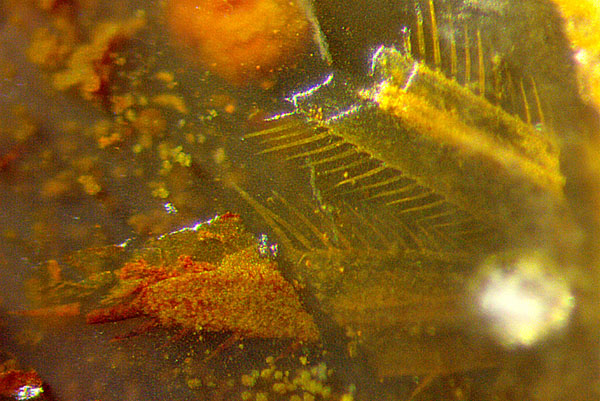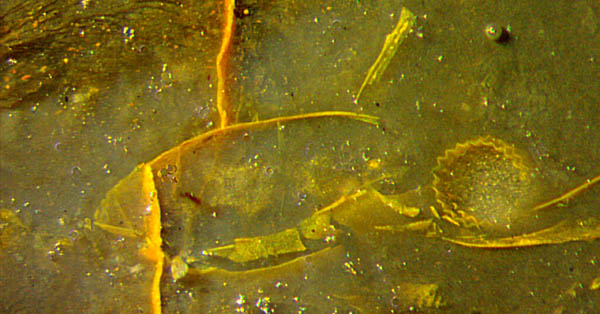Uronectes
in translucent chert

When this tiny
fishbone-like structure appeared beneath the
polished face of
a big Permian chert lump found in 1995 in the Doehlen Basin, it came as
a surprise since these
cherts had not offered any creatures before.
Soon it became apparent
that this fossil is part of the tail of the crustacean Uronectes. [1,2]
Fig.1: Fragments of two of the five tail fins of
the Permian crustacean Uronectes.
Image width 1.4mm.
The 3D-aspect of the tail fins in this image is
made more
evident by the thin white lines, which are light reflections marking
the small depressions on the polished chert face where there had been
no chert but organic substance of the fin. From the shape of the
white-lined inclined section it
can be concluded that the stiffness of the fin had been provided by a
flat hollow tube of roughly rectangular cross-section.
The less well seen tail fin below in Fig.1 reveals
other details: There is no fishbone-like aspect on one
side of the fin but sturdy bristles instead, poorly visible, with
larger spacing.
The biggest bristle is at the end on the left. So it appears
that the tail fins in Fig.1 differ from those pictured in
[1,2].

Fig.2: Fragments of unidentified parts of the
Permian crustacean Uronectes.
Image width 1.4mm, tube width 0.2mm.
More fragments of tail fins and exuviae
of Uronectes
have
been found in the same chert sample. Most
conspicuous in Fig.2 is the tube where the shadow inside supports a 3D-aspect of an uncommon corrugation with folds
arranged along the tube. (In engineering applications, the folds usually
run around the tube for better flexibility.)
A bright yellow crack, vertical in Fig.2, differs clearly from the pale
yellow exuvia fragments: When it came upon a fragment offering an easy
path for crack propagation, it followed that path until it resumed its
vertical direction.
A few more chert samples with Uronectes
have
been found since but not yet evaluated.
Sample: B/52, found in 1995 at
Bannewitz, Doehlen Basin, Saxony.
H.-J.
Weiss
2022
[1] D. Uhl:
Uronectes
... aus dem Rotliegend ... des Saar-Nahe-Beckens. Mitt. POLLICHIA 89
(2002), 43-56.
[2] H. Poschmann, D. Uhl:
Syncaride Krebse im Häutungshemd ..., Mitt. POLLICHIA Nr.10 (2007), 164-168,
in: "Kohlesümpfe, Seen und Halbwüsten, Dokumente einer rund 300 Millionen
Jahre alten Lebewelt zwischen Saarbrücken und Mainz", Kapitel:
Syncaride Krebse ..., Eds.: T. Schindler, U.H.J. Heidtke.
 |
 42 42 |

 42
42


 42
42